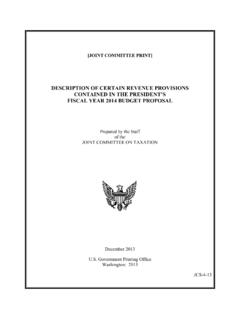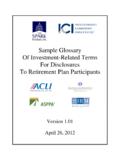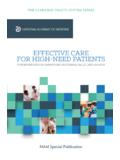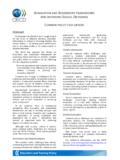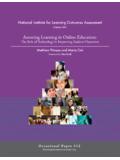Transcription of Improving Outcomes with Electronic Delivery of Retirement ...
1 I Improving Outcomes with Electronic Delivery of Retirement Plan Documents Prepared for The SPARK Institute June, 2015 i Improving Outcomes with Electronic Delivery of Retirement Plan Documents CONTENTS EXECUTIVE SUMMARY ..1 I. Restrictive Framework Guiding Electronic Delivery ..3 A. Overview ..3 B. DOL and IRS Electronic Delivery 1. DOL s Electronic Disclosure Safe Harbor ..6 2. DOL s Interpretive and Technical Guidance ..7 3. IRS s Media Disclosure Guidance ..7 C. Online Access Offers the Potential to Expand Electronic Delivery ..8 II. Conducting Financial Business Online ..11 A. Use of Electronic Methods in Financial Transactions ..11 B. Efficiencies and Cost Savings.
2 14 1. Efficiencies ..14 2. Cost Savings ..16 3. Electronic Delivery Benefits Participants ..17 III. Improving Participant Outcomes through Electronic Delivery ..19 A. Attitudes toward Electronic Delivery of Plan B. Enhancing Retirement Savings through Electronic Delivery ..20 C. Automatic Features with Opt Out Improves Outcomes ..22 1. Auto Enrollment Increases Participation and Deferral Rates ..23 2. Increasing the Power of Default Rules ..24 IV. CONCLUSION ..25 APPENDIX A PLAN PARTICIPANT VIEWS ON PAPER VERSUS Electronic Delivery OF PLAN DOCUMENTS ..26 APPENDIX B TECHNICAL DESCRIPTION OF COST SAVINGS ..40 REFERENCES ..46 ii LIST OF TABLES Table 1 Disclosure Requirements and Electronic Delivery Options.
3 5 FIGURES Figure 1 Some employers would like to automatically provide employees Retirement plan information by e-mail or through continuously available secure website ..19 Figure 2 Some Retirement plans offer tools or calculators that allow you to compute such things as how good a job you are doing in preparing for Retirement ..20 Figure 3 Benefits Accruing to Participants ..41 LIST OF GRAPHS Graph 1 Availability of Computers and Internet Access in the Home, Percentage of Households, Selected Years ..8 Graph 2 Internet and Computer Access by Employment Status, Graph 3 Computer and Internet Access at Home, by Age ..10 Graph 4 Preferred Banking Method, All Customers ..12 Graph 5 Preferred Banking Method, Customers Age 55 Years or Older.
4 12 Graph 6 Electronic Payment Rates for Social Security and Supplemental Security Income Payments, 1996 through Graph 7 Percent of Individual Income Tax Returns Filed Electronically, 2001 through 2014 ..14 Graph 8 Average Deferral Rates for Plan Participants, by Age and Electronic Delivery Status ..21 Graph 9 Average Deferral Rates for Plan Participants, by Age and Electronic Delivery Status ..21 Graph 10 Average Account Balance by Electronic Delivery Status, by Participant Age ..22 Graph 11 Participation Rates among Automatic Deferral Options ..24 Graph 12 Pension Access, by Firm Employment Size, 2014 ..42 Graph 13 Percentage of Pension Plans and Participants, by Plan Size, 2012.
5 42 Graph 14 Percentage of Plan Administrators and Employment, by Firm Size, 2012 ..43 1 EXECUTIVE SUMMARY Employers that voluntarily choose to offer defined contribution Retirement plans, such as 401(k) plans, are required to distribute numerous statements and disclosures both quarterly and annually. Many plans would like, as a default, to distribute Retirement plan information electronically. All participants would be given the right to opt out and receive paper communications at no charge. But current rules stand in the way. The Department of Labor (DOL) and Internal Revenue Service (IRS) have issued extensive guidance governing the manner in which plans can distribute Retirement plan information electronically.
6 But depending on the nature of the information, any one of four different IRS or DOL standards can apply. In some contexts, plans can default participants into Electronic Delivery ; for other information it is necessary to sign up each participant for Electronic Delivery which entails a formidable battle against inertia. Lack of consistency causes considerable confusion for Retirement plan administrators and their participants alike. Today s highly restrictive framework guiding Electronic Delivery of plan information is trapped in the Twentieth Century; this framework reflects neither recent years emerging information trends and technologies nor these trends and technologies many benefits for both participants and plan administrators.
7 Yet as reported in a Greenwald & Associates survey, plan participants are aware of the many potential benefits of Electronic Delivery and they overwhelmingly find it acceptable to make Electronic Delivery the default method of delivering of plan information. Besides reducing costs (with savings significantly passed through to plan participants), Electronic Delivery provides an efficient and reliable means of communicating important plan information, which facilitates superior participant Outcomes . This White Paper examines the many rationale for allowing plan sponsors to make Electronic Delivery the default method for communicating with Retirement plan participants. Findings Online Access Offers the Potential to Expand Electronic Delivery Recent surveys indicate that virtually all Americans have access to online services, in the workplace and/or at home.
8 Access is broad across age group, race, household income, and region. Conducting Financial Business Online Alongside dramatic growth in computer and Internet use, so too has Americans reliance on Electronic technology for financial communication and transactions grown significantly. This growth has taken place in areas of critical importance to everyday life: Banking and Financial Transactions Online and mobile phone banking is fast becoming the preferred banking method across all age groups. Social Security Benefits Nearly all Social Security recipients ( percent in 2014) receive their benefits through Electronic payment. Federal Income Tax Filing The trend to file individual tax returns electronically continues to experience steady growth.
9 Specifically, 85 percent of the 137 million returns filed as of May 16, 2014 were filed electronically. Since conducting day-to-day financial transactions online serves as a proxy for a Retirement plan participant s willingness to receive electronically plan-related notices, disclosures, and statements, the move toward conducting day-to-day financial transactions is a strong indicator that participants would prefer and benefit from Electronic Delivery of plan information. 2 Benefits of Electronic Delivery Relying on paper communication is both inefficient and costly. Even the federal government has recognized in its defined contribution plan for federal employees that Electronic Delivery of plan information is the appropriate default.
10 Electronic Delivery : Allows participants to respond quickly to plan information received electronically; Ensures information remains up-to-date and is accessed by participants in real time; Provides information that is more accessible and digestible; Provides information that can be more readily customized; and Provides a better guarantee of actual receipt of information. Cost Savings Compared to distributing plan documents by mail, Electronic Delivery has significantly lower costs, with savings from printing, processing, and mailing. A recent study estimates that moving from paper to Electronic Delivery of certain documents could reduce costs of producing communications by 36 percent.
